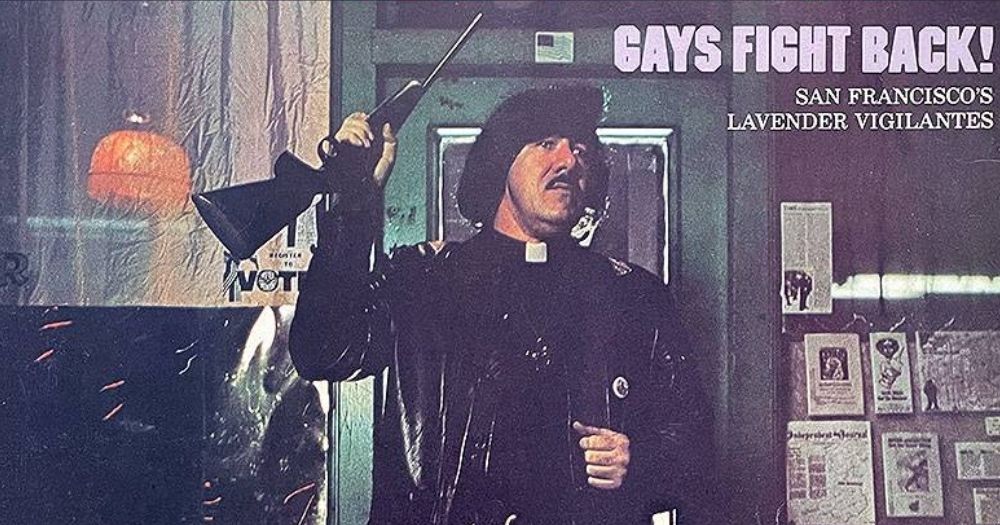The Lavender Panthers were a queer vigilante group dedicated to protecting queer people in San Francisco, California, during the ’70s. Raymond Broshears, a gay priest from Illinois, started the group after years of watching queer spaces being raided by police and attacked by gangs.
Broshears had been active in the Tenderloin, a neighbourhood known for its economic disadvantage in San Francisco, for years, working as both a priest and an activist. He had been frustrated with local gay rights movements, which were run by middle-class white gay men and often ignored trans people, poor people, and sex workers to appeal more to straight society. Broshears’ work focused on the people these movements ignored, which led to conflict with local law enforcement.
He watched authorities raid gay bars, arrest trans women off the streets, and posited that queer people were terrified to report assault to the police because they felt they would be blamed. Overall, Broshears was displeased with the society in which he lived, vying for change.
On the night of June 4, 1973, the priest called the police on a group of teenagers who were setting off fireworks during an event at the Helping Hands Service Center. The teenagers waited for Broshears to leave the centre and then attacked him.
In a nearby hospital, Broshears sat with a temporarily paralysed arm and wounds on his face, seething as he devised a plan. Smithsonian Magazine reports that two days later, he called together a press conference, where he arrived with other disgruntled queer and trans people, holding guns and declaring the establishment of a protective group called the Lavender Panthers.
For the following year, the Lavender Panthers would roam the streets of San Francisco until they either received a call about queer people being in danger or saw queer people being harassed. They patrolled the streets with sawed-off pool cues, clubs, whistles, red spray paint, and chains, according to Smithsonian Magazine.
Broshears explained he got the name from the Black Panthers that operated in Oakland, California, but it is unclear whether the Black Panthers were aware of the Lavender Panthers’ existence. Compared to the Black Panthers, the Lavender Panthers enjoyed less success in their existence, along with a smaller number of members.
The most notable encounter with the Lavender Panthers was when two gay men were leaving a bar called the Naked Grape and were harassed by four teenagers. Before the teenagers could hurt them, the Lavender Panthers arrived, scaring the teenagers off.
While the people of Tenderloin were happy with the Lavender Panthers’ protection, many of the local gay rights movements saw Broshears and his Panthers as a setback to the cause. Frank Fitch, a spokesperson for the Society of Individual Rights, which sought to affirm lesbian and gay identities and reduce violent crimes, said that Broshears did not represent the queer community.
“While we recognize that there does exist a climate of hate, fear and ignorance against gay people in this country, and that that climate often results in violent acts perpetrated against us, we feel that the use of violence to respond to violence solves nothing,” Fitch said.
Along with this, the priest was less than an upstanding individual, having been charged with groping a 17-year-old boy, though the charges were later dropped, and being a known associate of Lee Harvey Oswald, the man accused of assassinating former US President John F. Kennedy.
In the end, he garnered criticism for not just his actions as the founder of the Lavender Panthers but also his character, outrageous claims, and unpleasant disposition.
By 1975, the Lavender Panthers had dissolved, leaving Broshears with what his friends thought was PTSD and trauma associated with his activism in the community and a lack of recognition compared to others. At age 46, Broshears suffered a cerebral stroke and passed away.
A journalist for the Bay Area Reporter released an obituary for him, including testimonies from his friends and his critics. In this obituary, some called him a danger to society while praising his wit and dedication towards queer liberation.
However, the neighbourhood he lived in, Tenderloin, is where the majority of his support came from. For the residents of Tenderloin, Broshears had dedicated his life to helping them thrive when the rest of society had cast them aside to live in poverty.
Though a complex character, Broshears’ diligence to a community of underprivileged and underserved people made him someone to revere.
Did you know we have a team of wonderful runners taking part in this year’s Dublin Marathon and raising funds for GCN? You can support our athletes at this link.
© 2025 GCN (Gay Community News). All rights reserved.
Support GCN
GCN is a free, vital resource for Ireland’s LGBTQ+ community since 1988.
GCN is a trading name of National LGBT Federation CLG, a registered charity - Charity Number: 20034580.
GCN relies on the generous support of the community and allies to sustain the crucial work that we do. Producing GCN is costly, and, in an industry which has been hugely impacted by rising costs, we need your support to help sustain and grow this vital resource.
Supporting GCN for as little as €1.99 per month will help us continue our work as Ireland’s free, independent LGBTQ+ media.

comments. Please sign in to comment.